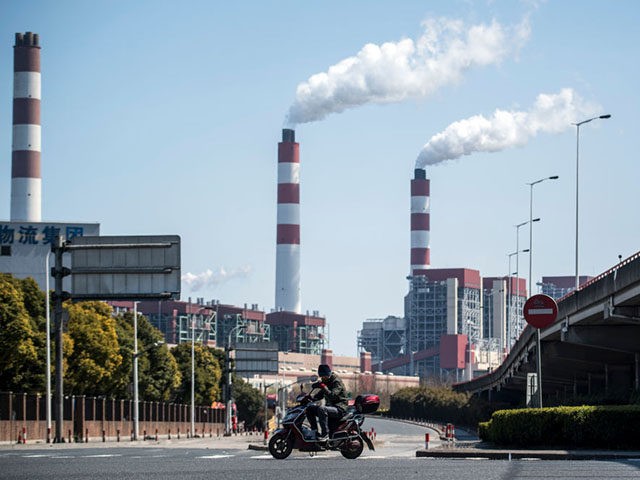The Chinese Ministry of Ecology and Environment claimed on Friday that the trade war between the U.S. and China is making it difficult for the latter to hit carbon emissions targets, even though Chinese researchers claimed just two weeks ago they were well ahead of schedule on meeting their emissions goals.
Although the world climate change movement reserves most of its criticism for the United States, China is the largest emitter of greenhouse gases, partly due to its heavy reliance on coal-fired power plants. Environmentalists bizarrely give China copious praise for setting ambitious carbon emissions goals even as China aggressively builds even more coal plants and exports them to other countries. The Chinese also persist in using illegal ozone-depleting refrigerants long ago banned in the countries constantly criticized by the climate change movement.
On Friday, the Chinese Communist government took a stab at blaming the lack of progress towards its boastful 2030 goals on U.S. President Donald Trump, as reported by Reuters:
Li Gao, head of the climate change office at the Ministry of Ecology and Environment, said on Friday the trade war had put China’s coal-reliant economy under heavy pressure.
“External elements, such as the Sino-US trade war, have brought negative impacts and increasing uncertainties to the global economy, which has also made it more difficult for China to tackle climate change,” he said.
China somehow managed to “raise hopes” among environmentalists that it would set even more ambitious targets for reducing carbon emissions in its next five-year economic plan, but Li explained those goals must regrettably be abandoned:
“Don’t underestimate the determination and confidence of the Chinese government, but at the same time, don’t underestimate the difficulties China is facing,” he said.
“China will not be able to meet the goal many years ahead of schedule and the process never goes easily or smoothly.”
[…]
Li told reporters China was still “heavily reliant” on fossil fuels and it was difficult to make adjustments, especially with the economy slowing.
“With the economy under downward pressure, the country has to take more measures to guarantee employment and the people’s livelihood,” he said. “Some of those measures may not fit our effort to tackle climate change.”
Li also said China was still unable to meet a major requirement of the Paris climate agreement to compile a full annual carbon inventory that should be submitted to the United Nations, as the country lacked staff and resources.
The last time Beijing was able to shake a few people loose to run a carbon inventory in 2014, its emissions had increased by over 50 percent in five years.
This month Chinese academics were churning out papers claiming the Communist regime was well ahead of schedule on meeting its 2030 carbon caps. From an August 14 article by Harvard University posted at Phys.org:
China, the world’s largest carbon emitter today, may be on track to meet its emission goals up to a decade early, according to a recent study on the cover of Nature Sustainability led by researchers from Nanjing University in Nanjing, China, and Harvard University.
The research focuses the relationship between urban economic growth and CO2 emissions. Fifty cities in China account for about 35 percent of China’s total emissions and 51 percent of its gross domestic product (GDP). By examining the emissions from these cities from 2000 to 2016, the researchers found a close relationship between per capita emissions and per capita GDP. The team found that carbon emissions for most cities stop rising and then begin to decline when GDP reaches around US $ 21,000 per person.
Using data on future population size and level of economic development from the World Bank, the researchers suggest that the nation’s total emissions could peak between 2021 and 2025 at 13-16 gigatonnes of CO2, well ahead of the 2030 commitment made by China under the U.N. Paris Climate Agreement.
“While China has a very long way to go to reduce its carbon emissions commensurate with the climate crisis, this paper shows that it appears on track to meet its formal obligations under the Paris Agreement, which remains in force despite a planned withdrawal by the U.S.,” Harvard researchers declared, unaware that by the end of the month China would be claiming the trade war crippled its ability to keep those promises.
Meanwhile, the United States continued to post remarkable sustained reductions in greenhouse gas emissions, without any significant problems reported from the trade war. The United States has, in fact, reduced carbon emissions more than any of the countries that remained in the Paris Agreement. The largest increases in carbon emissions have come from China.

COMMENTS
Please let us know if you're having issues with commenting.